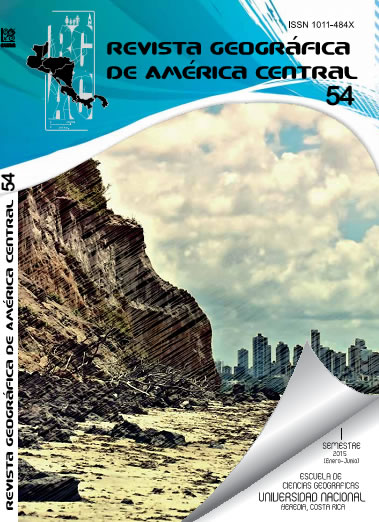SPACE-TIME ANALYSIS OF MALARIA IN MATINA, LIMÓN, COSTA RICA
DOI:
https://doi.org/10.15359/rgac.1-54.3Keywords:
Plasmodium spp., malaria, Costa Rica, Región Huetar Atlántica, GISAbstract
The purpose of this study was to describe the space-time pattern of the disease, and relate it to environmental factors. Spatial technologies were used to collect, store, analyze and display information regarding locations and household locations. Non-spatial attributes were analyzed using parametric and non parametric tests. The information was obtained from databases of clinical cases form the Governing Area of the Health Ministry in Matina. Centrographic parameters were calculated for localities within Matina and for households within the pilot location. Parasitic Incidence (IPA) was associated with a proposed environmental classification for Matina. At the household level, risk factors were determined. The temporal pattern of the disease in Matina is described. A similar temporal trend is shown for households within the pilot location. This is the first time that the information collected in the Matina Governing Area is used to describe the spatial patterns of malaria. This pattern will be useful as a comparative baseline for future studies.References
Alegana, V., Atkinson, P., Wright, J., Kamwi, R., Uusiku, P., Katokele. S., Snow, R. y Noor, A. (2009). Estimation of malaria incidence in northen Namibia in 2009 using Bayesian conditional-autoregressive spatial-temporal models. Spatial and Spatio-temporal Epidemiolo gy, 7, 25-36.
Fuller, D.O., Troyo, A., Alimi, T.O. y Beier, J.C. (2014). Participatory risk mapping of malaria vector exposure in northern South America using environmental and population data. Applied Geography, 48, 1-7.
HanafiBojd, A.A., Vatandoost, H., Oshaghi, M.A., Charrahy, Z., Hagh doost, A.A., Zamani, G., Abedi, F., Sedaghat, M.M., Soltani, M., Shahi, M. y Raeisi, A. (2012). Acta Tropica, 122,132-137.
Herrera-Soto, W. y Gómez-Pignataro, LD. 1993. Mapa de Unidades Bió- ticas de Costa Rica.
Lek-Uthai, U., Sangsayan, J., Kachenchart, B., Kulpradit, K., Sujirarat, D. y Honda, K. (2010). Novel ellipsoid spatial analysis for determining malaria risk at the village level. Acta Tropica,116, 51-60.
Nath, M.J., Bora, A.K., Yadav, K., Talukdar, P.K., Dhiman, S., Baruah, I. y Singh, L. (2013). Prioritizing areas for malaria control using geogra phical information system in Sonitpur district, Assam, India. Public Health, 127 572-578.
Ngom, R. y Siegmund, A. (2014). The key role of socio-demographic and socio-environmental factors in urban malaria occurrance and con trol- An illustration using the city of Yaoundé. Social Science and Medicine xxx, 1-11.
Ortiz, E. (2004). Atlas digital de Costa Rica. Versión 2004. Instituto Tecnológico de Costa Rica.
Tosi, AJ. (1969). Mapa Ecológico de Costa Rica basado en zonas de vida. Centro Científico Tropical. San José. Costa Rica.
Zayeri, F., Salehi, M. y Pirhsseini, H. (2011). Geographical mapping and Bayesian spatial modeling of malaria incidence in Sistan and Balu chistan province, Iran. Asian Pacifi Journal of Tropical Medicine xxx, 985-992.
Downloads
Published
How to Cite
Issue
Section
License
Proposed policy for journals offering Open Access
Authors publishing their works in the Journal acknowledge and agree to the following terms:
a) Authors retain the copyrights to their works and guarantee the Journal the right to be the first to publish their works, under the Creative Commons License Attribution-NonCommercial-ShareAlike 4.0 International, CC BY-NC-SA 4.0 International (https://creativecommons.org/licenses/by-nc-sa/4.0/deed.es), which allows others to share works upon complying with the acknowledgment of authorship and mention of the Journal as the original publisher of the work.
b) Authors are permitted to separately establish additional agreements for the non-exclusive distribution of the official edition of the work published in the Journal (for example, authors may desire to place the work in an institutional repository or incorporate it into a book that is to published elsewhere) so long they acknowledgment to recognize the Journal as the original publisher. The aforementioned additional agreements must respect the terms of the non-profit character and sharing philosophy of the original license (CC BY-NC-SA 4.0 International, https://creativecommons.org/licenses/by-nc-sa/4.0/deed.es).
c) Authors are encouraged to archive the post-print or editor/PDF version in Open Access repositories.






 REVGEO is licensed under https://creativecommons.org/licenses/by-nc-sa/4.0/deed.es
REVGEO is licensed under https://creativecommons.org/licenses/by-nc-sa/4.0/deed.es
.svg_4.png)

_(1).png)
_(1)_(1)_(1)_1.png)
(2)(1)(1)(1).png)
